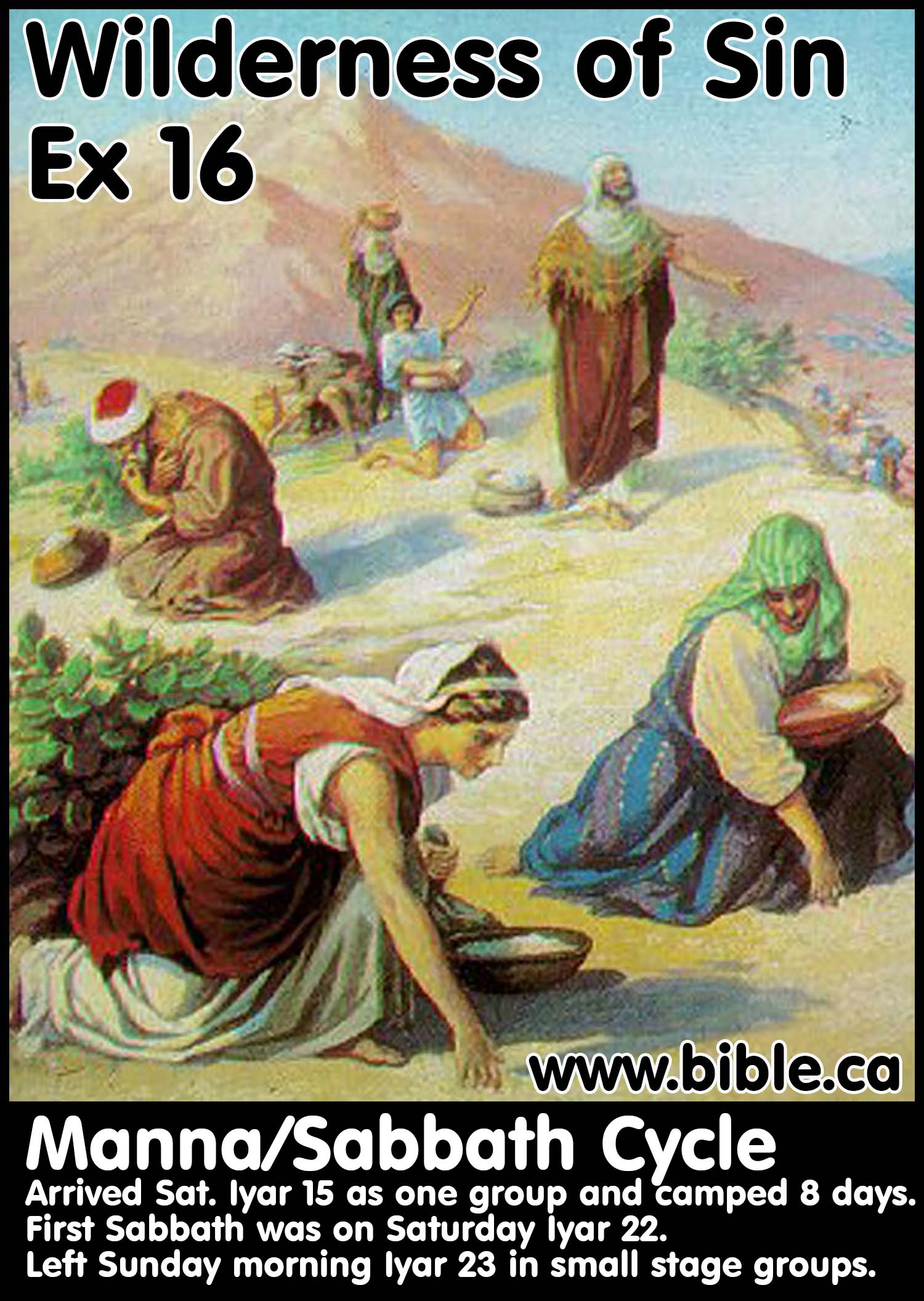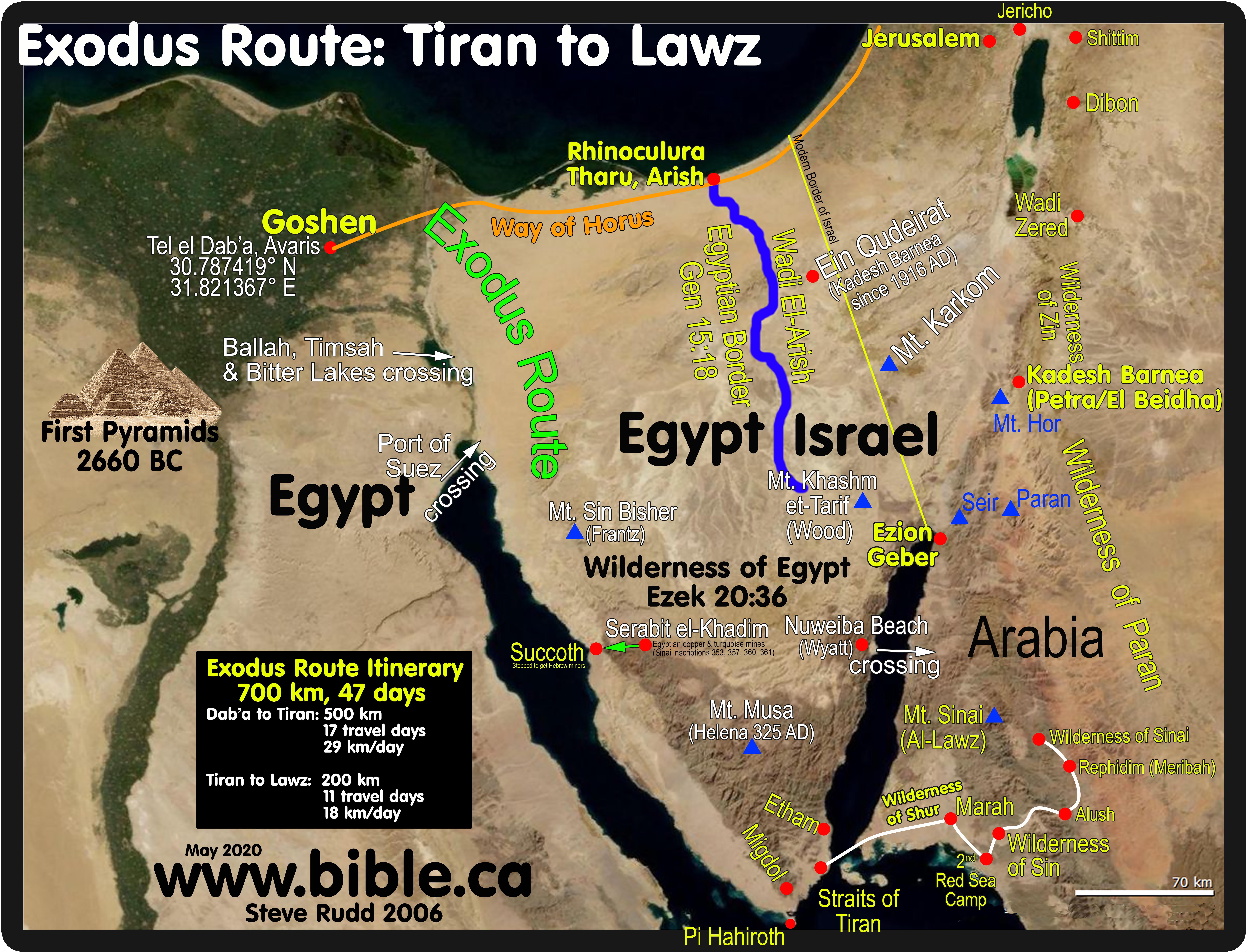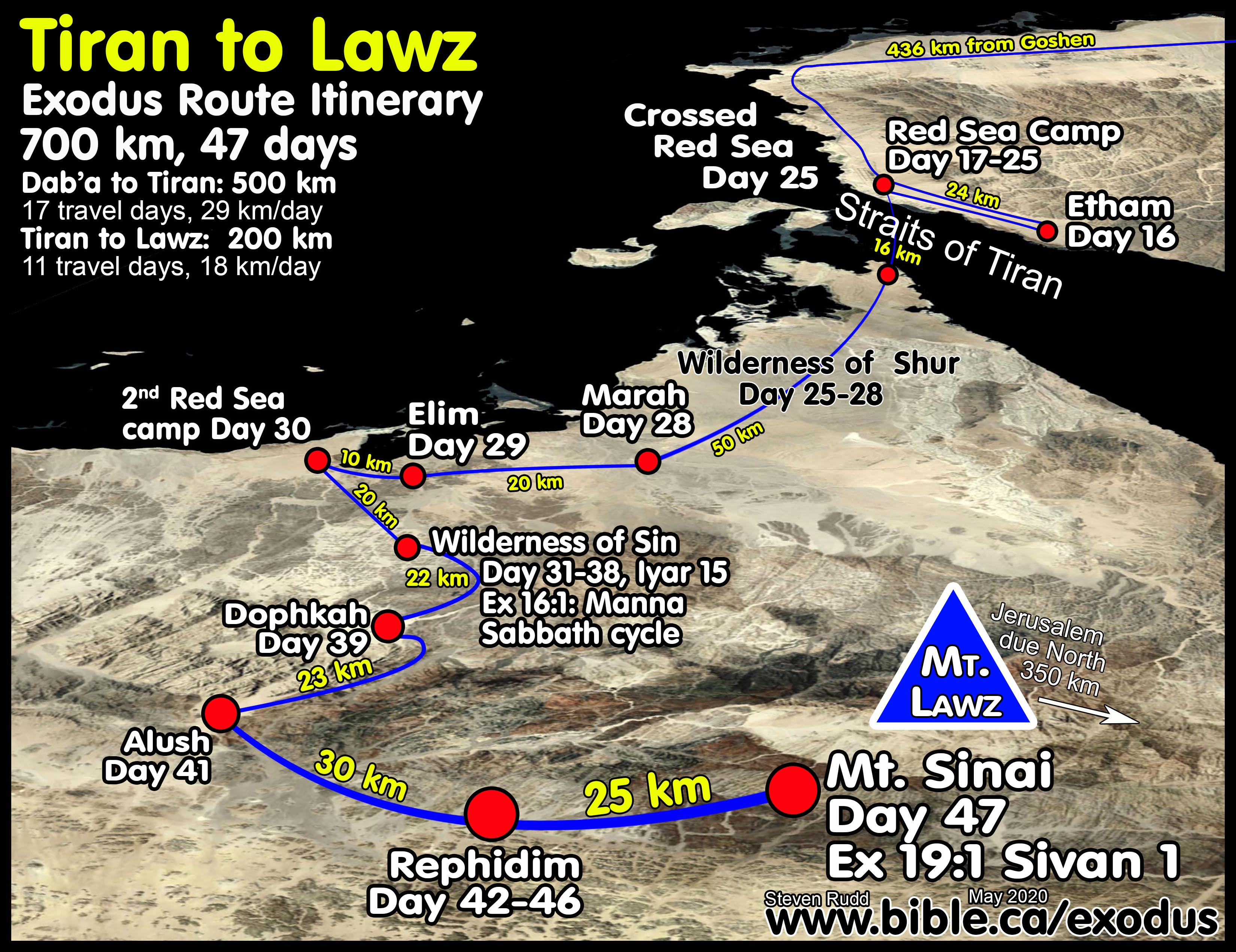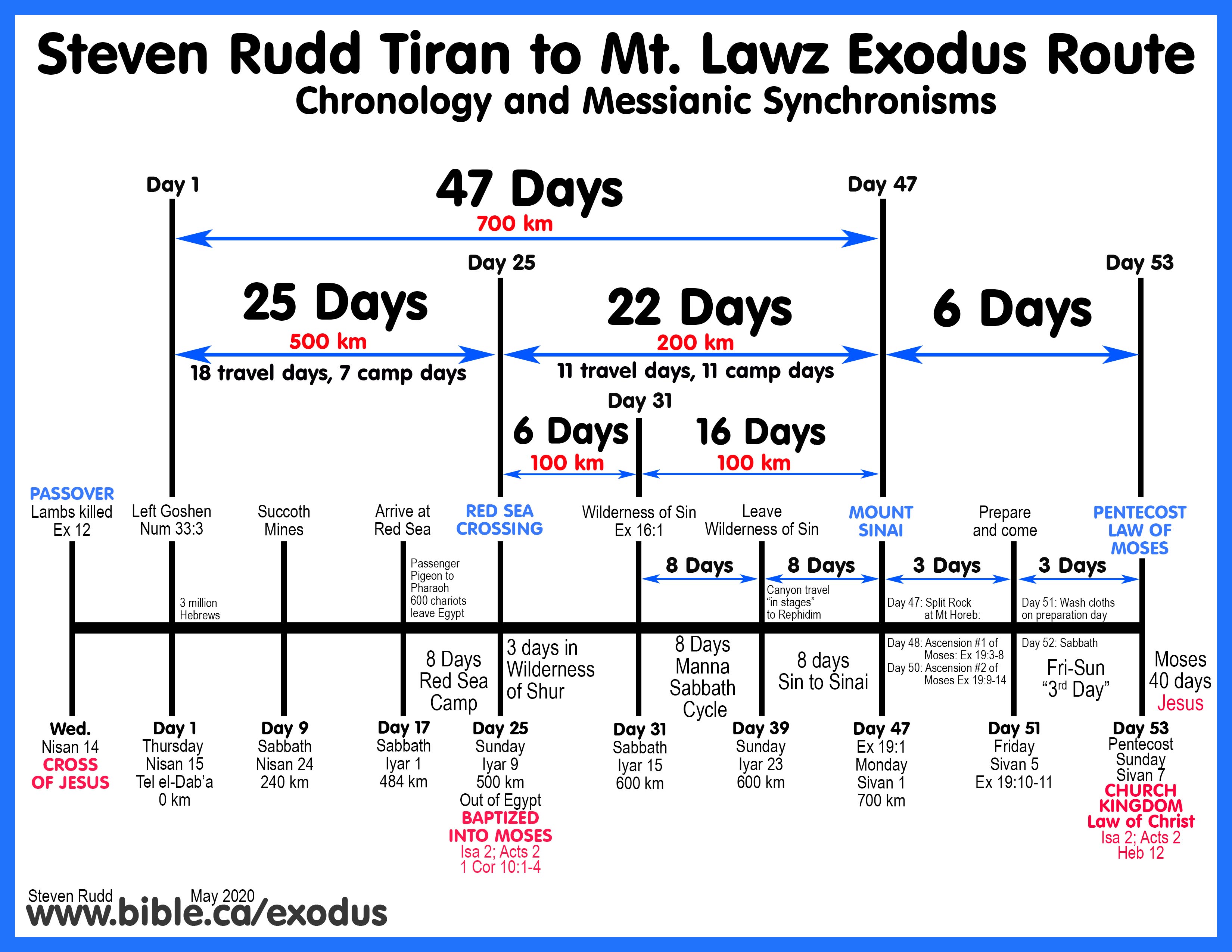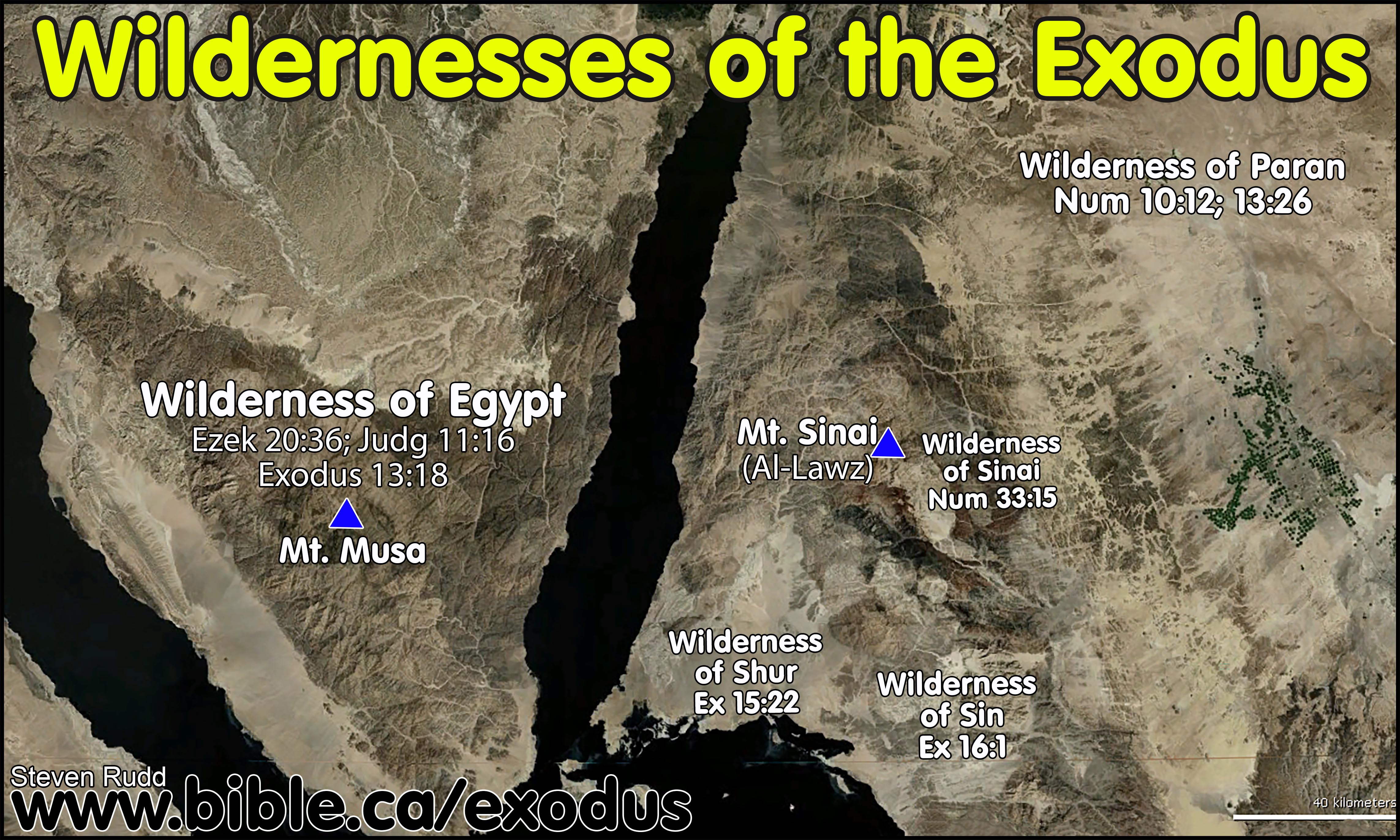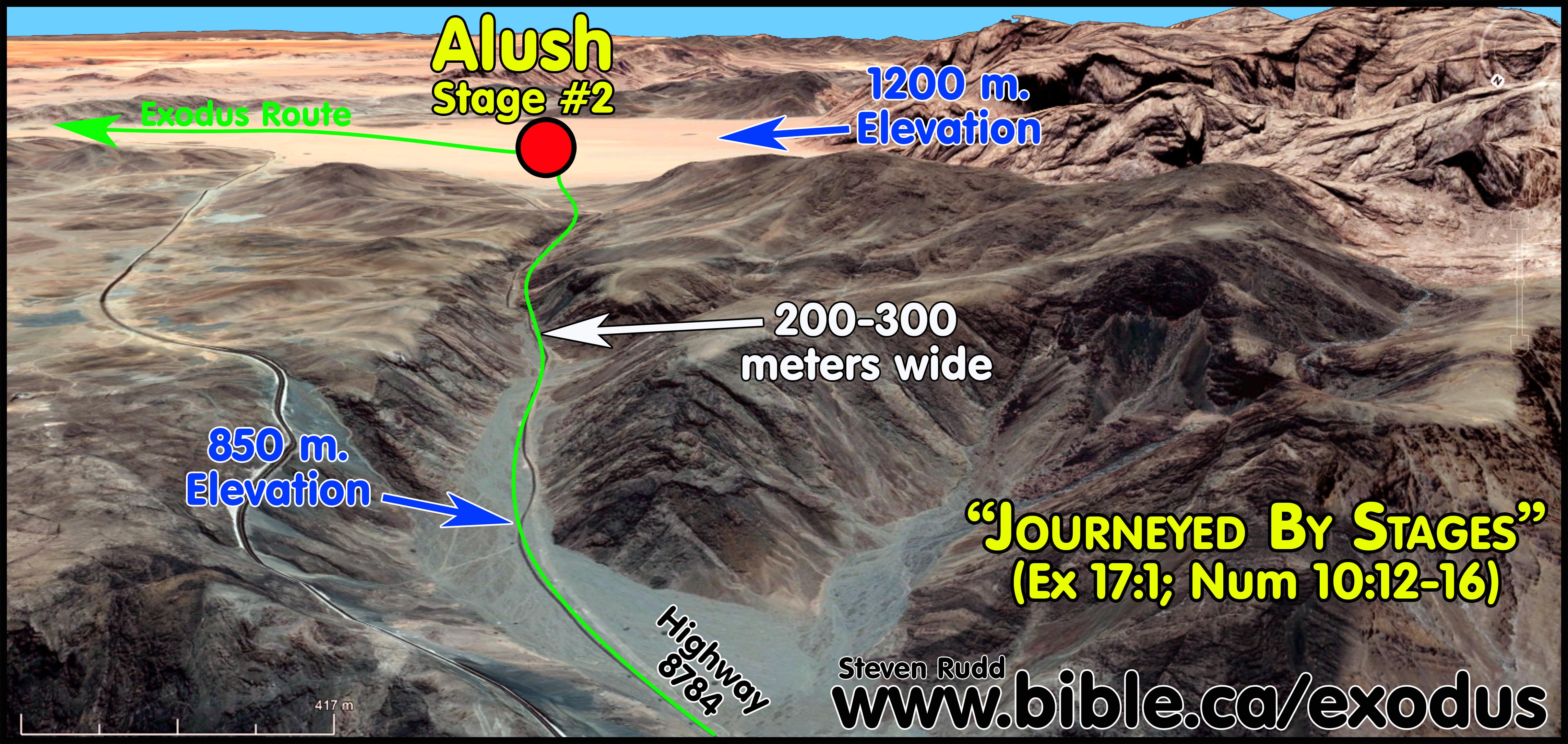The Exodus Route: Wilderness of Sin:
|
Wilderness of Sin The Manna/Sabbath Cycle (Manna, Quail, Sabbath) |
|
|
Exodus locations:
|
Introduction:
1. The Wilderness of Sin marks a critical chronological marker of 31 days of travel from Goshen: Ex 16:1
a. They left Goshen on the 15th of Nisan and arrived on the 15th of Iyar, which is 31 days in a 30 day lunar calendar.
b. The arrived in the Wilderness of Sinai on the third new moon on day 47 from Goshen: Ex 19:1
2.
Both the Wilderness of Sinai and the Wilderness of Sin are a large flat
plane that abuts the central Mt. Sinai mountain range.
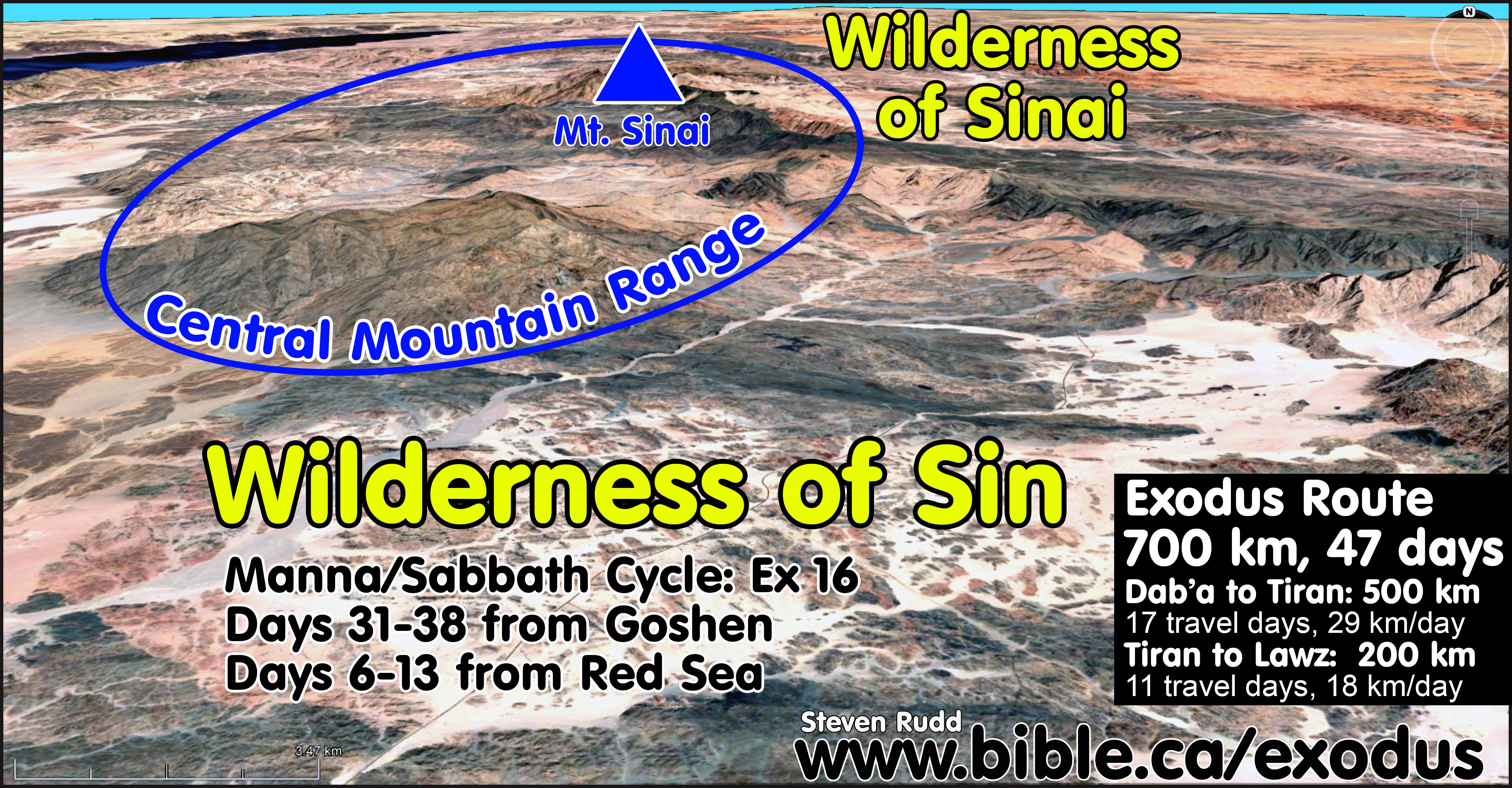
a. The Wilderness of Sin abuts the central mountain range at the south.
b. The Wilderness of Sinai abuts the central mountain range at the east.
3. Etymology of Sin and Sinai:
a. Both Sin and Sinai root from the Hebrew word for “thorny”.
b. Sin and Sinai refer to the moon god, which was the ancient deity of Arabia in 1446 BC at the time of Moses, down to the time of Muhammad in AD 610. The moon god was worshipped at Hazor at the time Moses, Joshua and Deborah.
c. Jethro and Moses viewed Mt. Sinai as the “Mountain of God”, the one true almighty God.
d. At the time of Moses, Mt. Sinai’s reputation among the local Ishmaelites, Midianites and Amalekites as the “mountain of God” was the moon god.
e. At the burning bush, Moses asked what the name of God was, perhaps because there was a difference of opinion between himself and the indigenous population. Moses knew the difference between pagan gods of Egypt and Arabia and the one true God. Jethro was a priest of the one true God.
f. At the time of Moses, the Mt. Sinai was associated with the pagan moon god which is why the two adjoining wildernesses were called Sinai and Sin.
4. Moses continued to use pagan name places in the Exodus:
a. Wilderness of Sin and Sinai = wilderness of the moon god
b. Baal-Zephon = Baal, god of the storm
c. Moses retained his Egyptian name from the 18th Dynasty pharaohs, including the pharaoh of the exodus: “ThutMOSES III”.
d. Daniel was renamed
e. Nebucahnezzar renamed Hebrew exiles with the names of the pagan gods Bel (Marduk) and Nebo:
i. Belteshazzar (Daniel): "Bel (Marduk) guard his life”
ii. Shadrach (Hananiah): "Marduk" (Bel) alternate corrupt spelling for Marduk
iii. Abednego (Mishael): "servant of Nebo" Nego is an alternate corrupt spelling of Nebo
iv. Belteshazzar (Daniel): "Bel (Marduk) guard his life”
5. Ex 16:1 tells us they arrived at the wilderness of Sin on the 15th day of the second month (Iyar 15).
a. Israel left Goshen on 15th Nisan and arrived at the Wilderness of Sin 31 days later.
b. The wilderness of Sin is the only place in the exodus route between Goshen and Mt. Sinai where the Bible tells us the date they arrived.
c. See: Travel times, distances, days of the week
6. This is where God first revealed the Sabbath and used Manna as the instructor.
a. They were instructed about the Manna/Sabbath cycle on a Saturday, had 6 days of Manna collection, then rested on their first Sabbath the following Saturday, then left Sunday morning for Mt. Sinai.
b. They got their first Manna at the wilderness of Sin and they were to collect it for 6 days, a double portion on the 6th day, then rest on the Sabbath for the first time in the history of humanity.
c. This is also where God sent Quails and Manna for them to eat: Exodus 16:10
7. Bible texts:
a. "Then they set out from Elim, and all the congregation of the sons of Israel came to the wilderness of Sin, which is between Elim and Sinai, on the fifteenth day of the second month after their departure from the land of Egypt." Exodus 16:1
b. "Then all the congregation of the sons of Israel journeyed by stages from the wilderness of Sin, according to the command of the Lord, and camped at Rephidim, and there was no water for the people to drink." Exodus 17:1
c. "They journeyed from the Red Sea and camped in the wilderness of Sin. They journeyed from the wilderness of Sin and camped at Dophkah." Numbers 33:11-12
d. "So You made known to them Your holy Sabbath (in the wilderness of Sin), And laid down for them commandments, statutes and law, Through Your servant Moses. (later at Mt. Sinai)" Nehemiah 9:14
e. "They journeyed from before Hahiroth and passed through the midst of the sea into the wilderness; and they went three days' journey in the wilderness and camped at Marah. They journeyed from Marah and came to Elim; and in Elim there were twelve springs of water and seventy palm trees, and they camped there. They journeyed from Elim and camped by the Red Sea. They journeyed from the Red Sea and camped in the wilderness of Sin. They journeyed from the wilderness of Sin and camped at Dophkah. They journeyed from Dophkah and camped at Alush. They journeyed from Alush and camped at Rephidim; now it was there that the people had no water to drink. They journeyed from Rephidim and camped in the wilderness of Sinai." Numbers 33:8-15
f. "It came about as Aaron spoke to the whole congregation of the sons of Israel, that they looked toward the wilderness, and behold, the glory of the Lord appeared in the cloud." Exodus 16:10
g. "He spread a cloud for a covering, And fire to illumine by night. They asked, and He brought quail, And satisfied them with the bread of heaven." Psalm 105:39-40
A. Keys to decoding the Wilderness of Sin:
1.
Elim, the wilderness of sin and Mt. Sinai must be lined up in a direct
line-of-sight sequentially: Ex 16:1
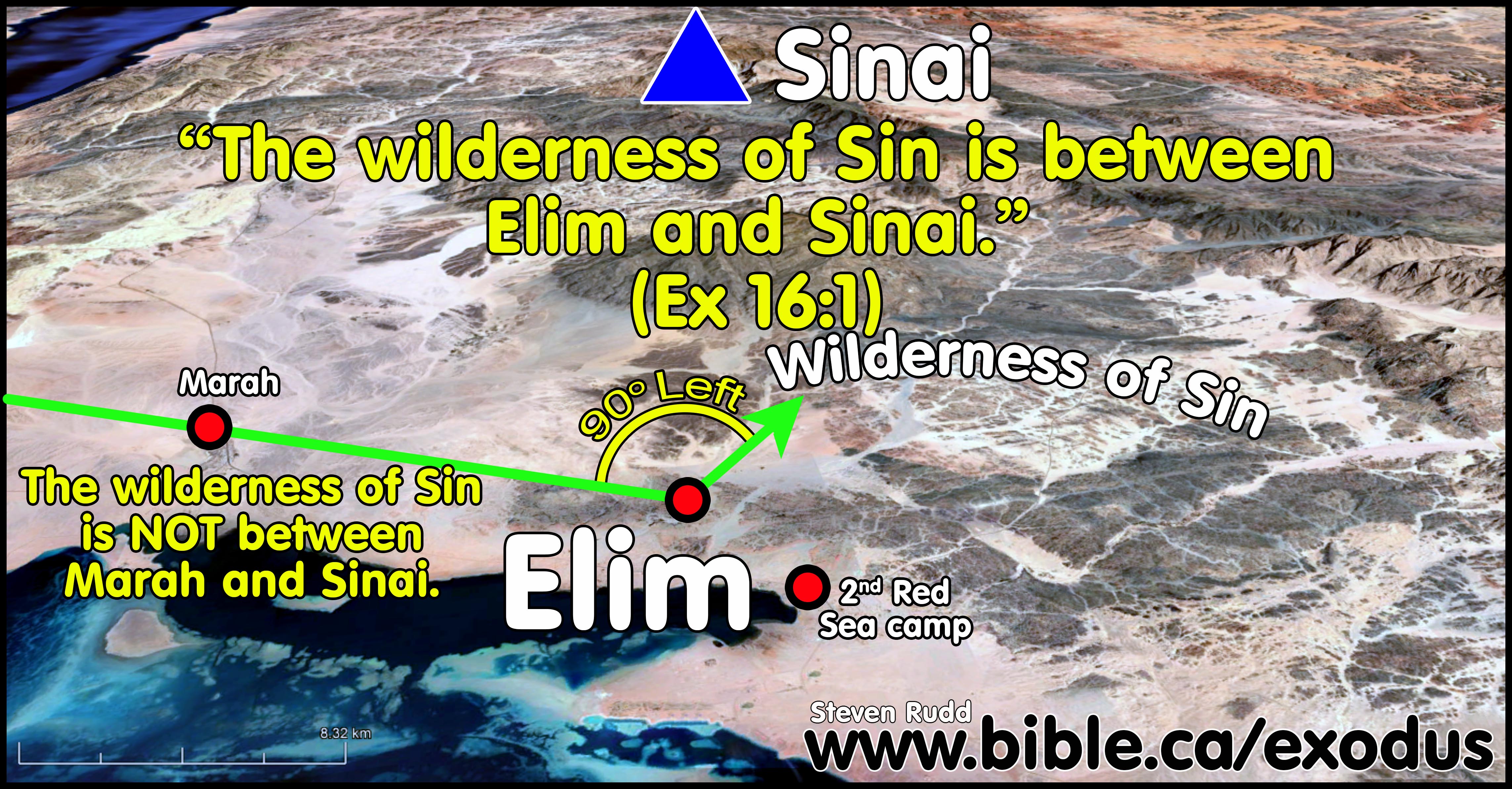
a. This sequential order is an important marker most ignore in the Red Sea Route by positioning Elim closer to Mt. Sinai than the Wilderness of Sin.
b. This marker also shows that for the first time since crossing the Red Sea, Israel was walking directly towards Mt. Sinai.
c. This is a perfect fit for the Tiran crossing because it is at Elim, that Israel makes a 90 degree turn left and begins for the first time to be making the final approach to Mt. Sinai which is directly ahead in line of site.
d. The Nuweiba route of Glen Fritz has the order backwards because his Elim (located at Al Bad) is between the Wilderness of Sin and Mt. Sinai. His line-of-site sequential order is Wilderness of Sin, Elim, Mt. Sinai and this directly contradicts Exodus 16:1 which says, “the wilderness of Sin, which is between Elim and Sinai”. This is a serious problem he was unaware of or failed to address in any way and represents a dissonance between his Nuweiba route and scripture.
2. After crossing the Red Sea, the first major directional change in course was at Elim: Ex 16:1 “Sin is between Elim and Sinai”
a. From the Red Sea to Elim, Israel was travelling east. After Elim Israel was travelling north. The route turned 90 degrees left at Elim.
b. The sequential marker (Elim, Sin, Sinai) must indicate a change in course at Elim because if “between” merely means the next stop on the itinerary, then the wilderness of Sin is also “between” Mt. Sinai and Marah, Etham, Succoth. In the Itinerary, the wilderness of sin was “between” both Marah and Elim, yet Moses excluded Marah because there was no direct line-of-sight between Marah, Wilderness of Sin and Mt. Sinai.
c. The special notation that the Wilderness of Sin is between Elim and Mt. Sinai proves this is a geographic vector sequence and not merely an itinerary sequence.
d. The inescapable conclusion is that the reason Moses takes special care to note that the Wilderness of Sin was between Elim and Sinai, is because Israel made a 90 degree left turn at Elim and for the first time, was heading towards Mt. Sinai in line of sight.
3. In Ex 16:1, the entire congregation arrived as a single group at the Wilderness of Sin on the same day.
a. This was day 31 from Goshen: Saturday, 15th day of the 2nd month, Iyar 15.
b. The reason this is critical, is because it was on Lyar 15 (a Saturday) that Moses first revealed the 7-day Sabbath/Manna cycle in the Wilderness of Sin. They learned that Manna would fall for six days: Sunday to Friday, which a double portion on Friday. Then Saturday, the 7th day, they were to rest and no Manna would fall. It is important that Israel arrived as a single group on a Saturday so they could all learn together about the Manna/Sabbath cycle.
c. The Glen Fritz Nuweiba crossing route splits the 3 million Hebrews into two groups when they first arrive at Elim (Al Bad). One group continues south to the Wilderness of Sin, arriving on Lyar 15 (Ex 16:1), while the second group travels one day through narrow canyons to modern Maqnah on the Gulf of Aqaba as the second Red Sea camp. This group retraces their steps back to Al Bad (Elim) then south to the Wilderness of Sin. The first group arrives at the Wilderness of Sin on Lyar 15 (Day 31) but the second group arrives two full days later on Lyar 17 (Day 33). This second group not only missed Moses’ instructions about the Sabbath/Manna cycle, for them, Quail suddenly appeared in the evening while they were at the second Red Sea camp, then the next day Manna suddenly appeared without explanation from Moses who was two days ahead. They then arrived at Elim on the second day of Manna while they camped for the second time at Elim on Monday. By the time the second group finally got to the Wilderness of Sin on Tuesday (the third day of Manna), the first group had already moved and were still two days ahead between Dophkah and Alush. The first group to arrive at the Wilderness of Sin experienced quail that same evening and Manna in the morning because they grumbled but the second group probably missed all this, being two days of travel away. This directly contradicts Ex 16:1-2 which twice says “all the congregation arrived” and “the whole congregation grumbled about food” the same day.
d. The Tiran route is a perfect fit for the entire 3 million Hebrews arriving at the Wilderness of Sin together as a single group on the same day.
4. In Ex 17:1, Israel camped a full 8 days at the Wilderness of Sin as a single group to learn the Sabbath/Manna cycle before moving to Dophkah.
a. Israel camped 8 days (days 31-38, Lyar 15-22), Saturday to Sunday, at the Wilderness of Sin then left for Dophkah the following Sunday.
b. "THEN all the congregation of the sons of Israel journeyed by stages from the wilderness of Sin, according to the command of the Lord, and camped at Rephidim" (Exodus 17:1)
c. The key is that only after all the events in chapter 16 had occurred “THEN” all the congregation left the Wilderness of Sinai.
d. Glen Fritz completely misses this important 8-day camp at the Wilderness of Sin to learn the Sabbath/Manna cycle and allows only one camp day at the Wilderness of Sin. Fritz splits the congregation up into two separate travel groups, two days apart. The first group arrives at the Wilderness of Sin on Lyar 15 as per Ex 16:1, then leaves for the unbiblical “third Red Sea Camp after only one camp day, then continuing to Dophkah. The second group arrives at the Wilderness of sin two days later on Lyar 17, completely missing Moses’ instruction about the Manna/Sabbath cycle while the first group has already moved from Dophkah and is arriving at Alush.
e. The Tiran route is a perfect fit but the Fritz’s Nuweiba route directly contradicts scripture.
5. Journey by stages between the wilderness of Sin to Rephidim
a. "Then all the congregation of the sons of Israel journeyed by stages from the wilderness of Sin, according to the command of the Lord, and camped at Rephidim, and there was no water for the people to drink." Exodus 17:1
b. This gives us important information about the type of terrain between Sin and Rephidim. There is only one reason they would travel by stages, and that is because they could not travel as one group because of the terrain.
c. In fact, from the time of leaving Goshen in Egypt, this is the first time they had to travel by stages. There is a wide coastal plain 300 km long down the east coast of the Gulf of Suez. After crossing the Red Sea at the Straits of Tiran, there is another wide open plain they could walk on until they get to the Wilderness of Sin. Between the wilderness of Sin and Rephidim are a number of narrow valleys about 200 meters wide. It is also more rugged and hilly. This would restrict the movement, so the Bible is right, they couldn't all go at once, but in stages between the two wildernesses plains. Amazing confirmation of the accuracy of the Bible story.
B. Calendar of events from Goshen to Sinai: Days 1-47
![]() Travel
times, distances, days of the week
Travel
times, distances, days of the week
|
Mon |
Tue |
Wed |
Thurs |
Fri |
Sat |
|
|
- |
- |
- |
Nisan 14: Passover lambs killed before sunset and eaten on Nisan 15 Wed evening. |
Day 1 Nisan 15: Departed in Daylight Num 33:3 |
2 |
3 Start counting 7 Sabbaths for Pentecost |
|
4 |
5 |
6 |
7 |
8 |
9 Succoth Overnight camp |
10 day 8 of Pentecost Nisan 24 |
|
11 |
12 |
13 |
14 |
15 Migdol |
16 Etham: Nisan 30 |
17 Iyar 1 |
|
18 camped at Red Sea |
19 Iyar 3 at Red Sea |
20 camped at Red Sea |
21 camped at Red Sea |
22 camped at Red Sea |
23 camped at Red Sea |
24 camped at Red Sea |
|
Iyar 9, saved and Shadow of First Fruits Lev 23:10-12 |
Day 1 after crossing |
28 Marah Day 3 after crossing |
29 Elim |
30 Iyar 14 Day 5 from Red Sea Crossing |
Wilderness of Sin. Ex 16:1. Day 6 from Red Sea Crossing |
|
|
32 camped at Sin, 1st Manna |
33 camped at Sin |
34 camped at Sin |
35 camped at Sin |
36 camped at Sin |
37 camped at Sin. Day 12 from Crossing |
38 camped at Sin. 1st Sabbath |
|
39 Iyar23 Day 14 Leave wilderness of Sin for Dophkah |
40 Dophkah, Alush (small stage groups) Day 15 from Red Sea Crossing |
41 Alush, Rephidim (small stage groups) Day 16 from Red Sea Crossing |
Israel grumbles for water: Ex 17:6 Amalek attacks |
Moses hands held up to win war. Moses’ altar: Ex 17:15. Jethro arrives, eats meal Ex 18:12 |
Moses Judges the people all day: Ex 18:13 |
45 Iyar 29 Rephidim 2nd Sabbath. Jethro’s Advice: Ex 18:17 |
|
46 Iyar 30 Moses implements Jethro’s advice and leaves: Ex 18:27. Israel leaves for Wild. of Sinai |
47 Sivan 1 Wilderness of Sinai: Ex 19:1 Split rock for water at Horeb: Ex 17:6. Day 22 from crossing |
Day 48 Sivan 2 1st ascension oath for people |
Day 49 |
Day 50 Sivan 4 2nd ascension be ready on the third day: Ex 19:7-14 |
51 Sivan 5 “preparation day” to wash clothes |
52 Sivan 6 Day 49 of Pentecost, 7th Sabbath. Seder Olam 5.31 |
|
53 Pentecost Sivan 7 Moses hears 10 Comm. and laws |
54 Sivan 8 |
55 4th ascension Moses ascends with Aaron. laws repeated Ex 20-23 |
56 |
57 5th ascension Moses, Aaron, Nadab, Abihu, 70 elders. |
58 |
59 |
|
Sun |
Mon |
Tue |
Wed |
Thurs |
Fri |
Sat |
1. Israel arrived on day 31 after leaving Goshen at the wilderness of Sin on the fifteenth day of the second month: Exodus 16:1
a. They arrived at the Wilderness of Sin on a Saturday, day 31 from Goshen: Ex 16:1
b. They camped 8 days at the Wilderness of Sin from Saturday to Sunday which represented days 6-14 from Red Sea and days 31-38 from Goshen.
c. They departed the Wilderness of Sin on Sunday, day 38 from Goshen: Ex 17:1
2. Calculating the days of the week for the exodus route itinerary:
a. The primary way we have used to calculate the days of the week for the exodus journey is based solely on their visit to the Wilderness of Sin because this is where God first revealed the Sabbath/Manna cycle.
b. Scripture tells us Israel spent at least 8 days in the wilderness of Sin: "Then all the congregation of the sons of Israel journeyed by stages from the wilderness of Sin, according to the command of the Lord, and camped at Rephidim, and there was no water for the people to drink." (Exodus 17:1)
c. All the events of the first Manna/Sabbath cycle occurred in the Wilderness of Sin THEN they left.
d. Since Manna fell the day after Moses’ instructions for the Manna/Sabbath six day cycle which began on the first day of the week (Sunday), this means that Israel arrived at the Wilderness of Sin on a Saturday.
e. Israel arrived from the second Red Sea camp at the Wilderness of Sin on a Saturday when Moses said the following day would be the first of six days of Manna.
f. Since Israel arrived at the Wilderness of Sin on day 31 from Goshen, by counting 6 days back from the Wilderness of Sin to the Red Sea crossing (3 day Marah, 1 day Elim, 1 day second Red Sea camp), we learn Israel crossed the Red Sea on a Sunday, left Goshen on a Thursday and arrived at Mt. Sinai on a Monday. Pentecost always fell on a Sunday, which in 1446 BC was day 53 from Goshen.
g. The only variable is if God spoke the words of Exodus 16:4-5 on a Saturday or not. However, we know the Holy Spirit has told us in Exodus 16:1, that they arrived in the Wilderness of Sin on the 15th day of the second month (day 31), we also know that they only had 16 more days to make it all the way to the Wilderness of Sinai. This means there is little time to spare, so it is likely we are correct that God spoke the words of Exodus 16:4-5 on a Saturday, not one or two days earlier. This urgency of 16 days to arrive at Mt. Sinai, also means it is very reasonable to have them leave early Sunday morning after the first Sabbath is over. They might have even traveled at night. The Bible says that they travel by night by the pillar of fire.
h. After camping in the Wilderness of Sin for 8 days, they departed early Sunday morning for Dophkah.
i. Here are more timing details: Travel times, distances, days of the week.
3. The Sabbath/Manna cycle:
a. "Behold, I will rain bread from heaven for you; and the people shall go out and gather a day's portion every day, that I may test them, whether or not they will walk in My instruction. On the sixth day, when they prepare what they bring in, it will be twice as much as they gather daily." Exodus 16:4-5.
b. God used Manna to teach them, for the first time, about the weekly Sabbath day. To do this, it would mean that they are camped in the Wilderness of Sin for the full week (Sunday - Saturday).
c. In Ex 16:1 God revealed the Sabbath for the very first time in world history. Contrary to the unbiblical ravings of Seventh-day Adventists, it is clear that Adam and Abraham never kept the weekly seventh day Sabbath (Saturday). In fact, the word Sabbath is never even used once in the book of Genesis. The Sabbath was a Jewish holy day that was abolished by God when he nailed the first covenant to the cross. Col 2:14-17 clearly teaches that the Law of Moses, including the 10 commandments, were nailed to the cross. The New Testament passages specifically state that Christians are free to eat "unclean foods" (pork) and that all the system of Jewish holy days, yearly (Passover), monthly (new moon) and weekly (7th day Sabbath) are all nailed to the cross. Christians do not keep the Jewish Sabbath, but worship on the first day of the week: Sunday. Christians assembled every 1st day (Sunday) for the Lord's Supper: Acts 20:7 and are commanded to give every Sunday: 1 Cor 16:2.
C. Photos and maps:
|
The wildernesses of the Exodus |
||
|
|
||
|
Here is the beach where they camped on day 5 from crossing, which was 18 km from Elim. |
||
|
Marah and Elim which are both in the wilderness of Shur. Distances are indicated from each stop. |
||
|
Terrain looking south to the Wilderness of Sin. |
||
|
Arial view of the difficult terrain between the wilderness of Sin and Rephidim. |
||
|
There were two stages: Stage 1: Dophkah Stage 2: Alush |
||
F. How the traditional choice for the Wilderness of Sin fails:
1. Israel arrived at the Wilderness of Sin on day 31 from Goshen and when they leave on day 38, there are only 9 left in order to reach Mt. Sinai on day 47: Ex 19:1 The Wilderness of Sin is the next stop after the second Red Sea camp (Num 33:10) so the two sites must therefore be close to each other.
a. A Nuweiba Red Sea crossing that takes a northern route around the mountain range to Mt. Sinai requires the Wilderness of Sin to be one stop from the second Red Sea camp, but instead puts the Wilderness of Sin on the east side of the Mountain range, which is too far away. Most of the time these routes totally ignore the second Red Sea Camp.
b. A Nuweiba Red Sea crossing that takes a southern route (Glen Fritz route) around the mountain range to Mt. Sinai has Israel arriving at the wilderness of Sin on day 31 just south of El Bad. After learning the Sabbath/Manna cycle during their 8-camp day at the Wilderness of Sin, Moses leaves for Sinai on day 38. There are only 9 days left in the itinerary, including at least 4 camp days at Rephidim, to reach Mt. Sinai on day 47. There are three days of slow canyon travel between Dophkah and Elush. Israel must travel 241 km in the remaining 5 travel days, three of which are slow canyon travel, at an average rate of about 50 km per day.
2. Glen Fritz makes five critical chronological errors in his Nuweiba crossing exodus route:
a. Fritz misinterprets the chronological marker in Ex 19:1 as being at a geographic location that is 3 days short of final camp spot at Mt. Sinai. Fritz marks 61 days from Goshen to the Wilderness of Sinai, then 2-3 more days to reach the final camp at in front of Mt. Sinai on day 64. Scripture never says Israel camped in the Wilderness of Sinai then journeyed to the foot of Mt. Sinai. Instead scripture equates the wilderness of Sinai as being equal to the final camp in front of Mt. Sinai. "In the third month after the sons of Israel had gone out of the land of Egypt, on that very day they came into the wilderness of Sinai. When they set out from Rephidim, they came to the wilderness of Sinai and camped in the wilderness; and there Israel camped in front of the mountain." (Exodus 19:1–2) In the Numbers 33 itinerary, the Wilderness of Sinai was the final camp spot for 11 months at Mt. Sinai: "They journeyed from Rephidim and camped in the wilderness of Sinai. [11 months, 5 days pass] They journeyed from the wilderness of Sinai and camped at Kibroth-hattaavah." (Numbers 33:15–16) It is unclear why Fritz would fabricate an extra stop at the Wilderness of Sinai before reaching Mt. Sinai in his itinerary which is not found in scripture. At 888 km, the Fritz Nuweiba route is so long, perhaps he knew he needed the additional 2-3 days to reach Sinai by day 64 at the latest.
b. Fritz miscalculates the journey as 61 days instead of the correct 47 days as per Ex 19:1. "In the third month after the sons of Israel had gone out of the land of Egypt, on that very day they came into the wilderness of Sinai." (Exodus 19:1–2) It is 47 days from Nisan 15 to Sivan 1 but Fritz misinterprets it as a 61 day journey from Nisan 15 to Sivan 15. Ex 19:1 speaks of the first sighting of the new moon marking the first day of the third month, not the 15th day of the third month. All ancient literary sources, including Josephus, are unanimous in confirming a 47-day period from Goshen to Sinai. See: Travel times, distances, days of the week
c. Fritz ignores the 8-day camp on the Nuweiba beach waiting for pharaoh on days 18-25. Although Fritz is correct that Israel arrived at the Nuweiba beach on day 18, he has Israel cross the Red Sea on day 19. Fitz not only ignored the time (5 days minimum on horseback) it would take for a messenger to be sent to Egypt after Etham (Day 15 at the earliest), he also ignores the time (minimum 7 days) for Pharaoh to read the message and travel to the Nuweiba beach on his horse drawn chariot. In Fritz’s flawed formulation, Israel has already left the wilderness of Sin about the time pharaoh arrives at the Nuweiba beach. To solve this huge problem, Fritz has pharaoh begin chasing the Hebrews on day 4 from Egypt, which is 10 days before Fritz has Israel “trapped in the wilderness” on day 14 at Etham. Incredibly, Fritz has Pharaoh overtaking the Hebrews at Etham with 4 more journey days before they reach the Nuweiba beach. Apparently pharaoh quietly trailed the Hebrews for 4 days until he decided to attack at the Red Sea.
d. Fritz has Israel arriving at the Wilderness of Sin on day 30 after leaving Goshen, apparently unaware that Nisan 15 to Iyar 15 calculates to 31 days in a 30-day lunar calendar. According to Ex 16:1, Israel arrived in the Wilderness of Sin on day 31 from Goshen. A 30-day Hebrew month is confirmed by Josephus in Antiquities 2.316 when he says Israel had 30 days of food, meaning they ran out on the 31st day when they entered the Wilderness of Sin. It is also possible to have up to 4 consecutive 30-day lunar months. Although Fritz transposed the two numbers 30 and 31, his route is still 61 days total, but it is 31 days from Goshen to the Wilderness of Sin in Ex 16:1 (Nisan 15 to Iyar 15) and 30 days more days to the wilderness of Sinai (Iyar 16 to Sivan 15).
e. Fritz ignores the 8-day camp at the Wilderness of Sin as a vehicle to learn the Sabbath/Manna cycle. He has Israel leaving the day after they arrive on day 31. Ex 17:1 says that Israel did not leave the Wilderness of Sin until after the 6 days of manna (Sunday to Friday) and first sabbath day. The 3 million Hebrews arrived on a Saturday as one group, listened to Moses’ instructions, camped 8 nights and left Sunday morning for Dophkah.
f. Fritz crosses the Red Sea too early on day 18 because Ex 16:1 indicates the Red Sea crossing was on day 25. Israel arrived at the Wilderness of Sin on day 31 (Ex 16:1). Scripture says Moses journeyed 3 days in the Wilderness of Shur to Marah (Ex 15:22–23). The next two stops are Elim then the second Red Sea camp which equals two days. Israel crossed the Red Sea on day 25 and camped, then traveled three days to reach Marah on days 26-28, then traveled to Elim on day 29, then traveled to the second Red Sea camp on day 30, then arrived at the Wilderness of Sin on day 31.
3. The Nuweiba Red Sea crossing is chronologically impossible because Israel cannot reach the Wilderness of Sin by day 31. The underwater land bridge at Nuweiba is comparable in slopes to the Tiran crossing. The difficult canyon travel on either side of Nuweiba crossing make the route impossible not the slope of the underwater land bridge.
By Steve Rudd: Contact the author for comments, input or corrections.
